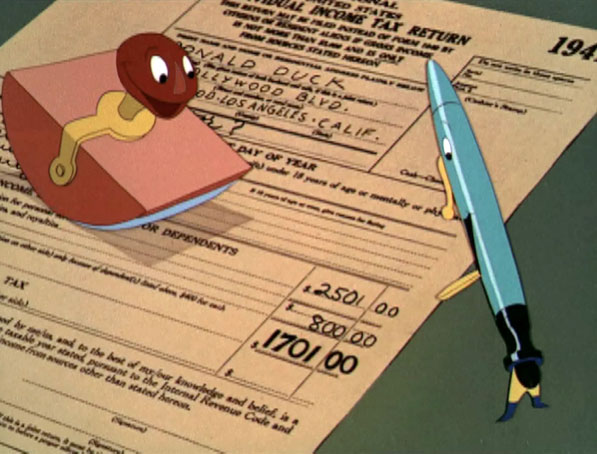
Scene 51, from The New Spirit, showing Donald Duck’s tax return with his deduction for dependents Huey, Dewey and Louie; ©Disney
This time of year, most Americans turn some of their attention to filing income tax returns by the April 15th deadline. So, it’s no surprise that in January of 1942, the Walt Disney Studios released a Donald Duck cartoon titled The New Spirit and a year later followed it up in January of 1943 with The Spirit of ’43, both made for the U.S. Treasury Department to extoll the virtues of paying your income taxes.
In the early 1940s, the U.S. introduced new tax laws. Some seven million taxpayers who had never filed income taxes before were added to the tax rolls. The Treasury Department looked to Disney for help in educating taxpayers with a public service announcement (PSA) for the movie theaters and the studio was already starting to do other films for various branches of the U. S. government. In a telegram to Walt Disney, his brother Roy O. Disney said, “will discuss… matter of having us [studio] designated as a defense plant per your wire and see what we can do.” The Disney Studios became a major supplier of training films, PSAs and educational films to the U.S. Government during World War II.
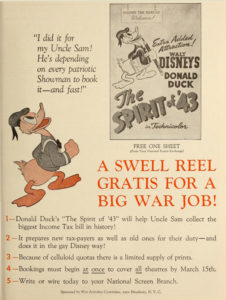 Shortly after the bombing of Pearl Harbor, Treasury Secretary Henry Morganthau, Jr. wanted a Disney-created “Mr. Average Taxpayer” character to help convey the importance of paying your taxes in the first of two shorts. But Walt Disney argued for Donald Duck as the spokesman, his most popular character at that time. Disney likened Donald Duck to lending out a leading movie star like Clark Gable to help educate the public in the theatres. Walt ultimately prevailed in his argument and Donald Duck became an advocate for paying income taxes.
Shortly after the bombing of Pearl Harbor, Treasury Secretary Henry Morganthau, Jr. wanted a Disney-created “Mr. Average Taxpayer” character to help convey the importance of paying your taxes in the first of two shorts. But Walt Disney argued for Donald Duck as the spokesman, his most popular character at that time. Disney likened Donald Duck to lending out a leading movie star like Clark Gable to help educate the public in the theatres. Walt ultimately prevailed in his argument and Donald Duck became an advocate for paying income taxes.
Calling long distance from Washington D.C. on Thursday, December 18, 1941, Walt Disney spoke to story man Joe Grant and director Ben Sharpsteen about the new tax picture. Walt explained, “The treasury dept. wants us to make a film. This a big order. By that I mean it is a tough job to handle. It is to be a film with Donald Duck making people like the fact that they have to pay income tax. It is going to tell how the tax problem plays its part in this war.” He continued, “The Treasury Dept. wants to put on a nationwide campaign before March 15 and this film will be run in all theatres.” The phone call continued with ideas for what the storyline would be for this first tax picture and they also briefly talked about other matters including doing a PSA for war bonds.
“They need all the help we can give them and they are anxious to get it,” said Walt.
“We will first work on the income tax film and then the bonds,” said Grant.
“Stick to the Donald Duck film as the main idea. Donald talks to the radio voice and between them they tell the story of the income taxes. This means that we will be running into over-time but we’ve got to move it through. We must pull out our best men for this thing regardless of what they are doing,” said Walt, “I want the best men and the men who can work with speed and economy. Don’t forget that we are making this on a cost basis and this film will have to cost as little as possible.”
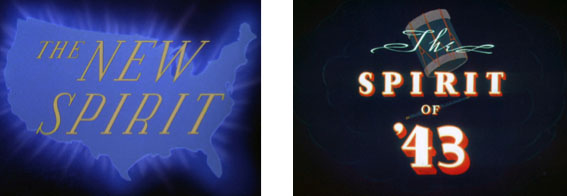
The title cards for The New Spirit and The Spirit of ’43; ©Disney
It was the Treasury Secretary whom unknowingly came up with the title of the film. Walt explained in the call, “The Secretary suggested this thought… it was a new spirit. That might be a good title for this picture.”
Walt’s conversation with Treasury Secretary Morganthau to do this film was essentially done on a handshake. There was no formal agreement initially spelling out the terms, only that Disney would do the film at cost. This arrangement would come back on Walt. When he went back to the Treasury for payment, Morganthau had to go to Congress to have the funds appropriated. That caused a dust up with some Senators accusing Walt of war profiteering. Ultimately, the Senate approved the funding. Roy did admonish Walt and stressed the need to get proper contracts in place beforehand with the terms spelled out.
 Despite the bad press in the Senate surrounding The New Spirit it received generally favorable reviews. The Chicago Tribune’s drama critic Ashton Stevens said, “When a movie laughs you into paying making out an income-tax return—and borrowing money to pay it on the line, that isn’t just pecuniary propaganda—that’s magic that partakes of the miraculous.” Thornton Delehanty of The New York Herald wrote, “Walt Disney’s first production for the Treasury Department should go an incalculable way toward easing the grief and dismay with which the public customarily views its income taxes.” The film was nominated for Best Documentary at the Academy Awards in 1943.
Despite the bad press in the Senate surrounding The New Spirit it received generally favorable reviews. The Chicago Tribune’s drama critic Ashton Stevens said, “When a movie laughs you into paying making out an income-tax return—and borrowing money to pay it on the line, that isn’t just pecuniary propaganda—that’s magic that partakes of the miraculous.” Thornton Delehanty of The New York Herald wrote, “Walt Disney’s first production for the Treasury Department should go an incalculable way toward easing the grief and dismay with which the public customarily views its income taxes.” The film was nominated for Best Documentary at the Academy Awards in 1943.
It is worth noting, that from the time Walt phoned Grant and Sharpsteen on December 18th to discuss the first tax picture story ideas, it took only about six weeks to complete The New Spirit and have prints struck at Technicolor. The full running time of the short is 7 minutes 21 seconds with a total 662 feet of animation. Of that, roughly 389 feet is the Donald Duck animation portion with the remainder of the film done in limited animation, camera moves on still art with optical effects and voiceover. Some of that animation is re-use including the whirlpool from The Sorcerer’s Apprentice, which is painted black, white and gray and swallows a swastika. It was common for Walt to re-use animation for these government funded films, it saved time and expense.
After the dustup in the Senate over appropriating funds to pay for The New Spirit had settled down, Jack King, a key animation director at the studio during those early years, was named director of the tax picture sequel, The Spirit of ‘43. He had assigned several animators to the project including Disney legend Ward Kimball. By this time, Kimball had established himself as a premiere animator at the studio with his work on Snow White and Seven Dwarfs, his design and animation of Jiminy Cricket for Pinocchio, and Bacchus along with his pet unicorn-donkey in Fantasia.
Joe Grant and Carl Barks were assigned to develop the story for The Spirit of ’43. Joe was noted for his strong story sense and had developed the storylines for Dumbo, Der Fuehrer’s Face, Thru the Mirror, as well as the first tax picture The New Spirit. Carl was best known for his work on Donald Duck comics, and is credited as the writer on numerous Donald Duck shorts including Donald’s Nephews, The Hockey Champ, Sea Scouts, and Chef Donald, among others.
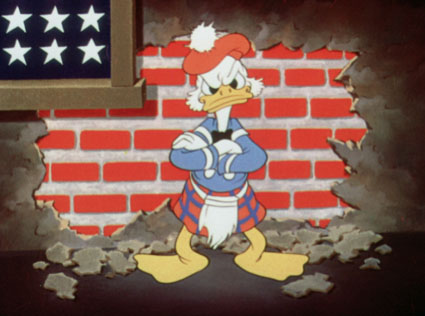
Donald Duck’s thrifty self from The Spirit of ’43 is a predecessor to Uncle Scrooge McDuck; ©Disney
The storyline for The Spirit of ’43 consists of Donald being torn between his spendthrift self and his more practical, thrifty self portrayed by a Scotsman that looks very much like a predecessor to Uncle Scrooge McDuck. The story for this short is a classic good vs. evil scenario. Good triumphs in the end, as it always should, with Donald racing off to the IRS office in Washington, D.C., to pay his taxes.
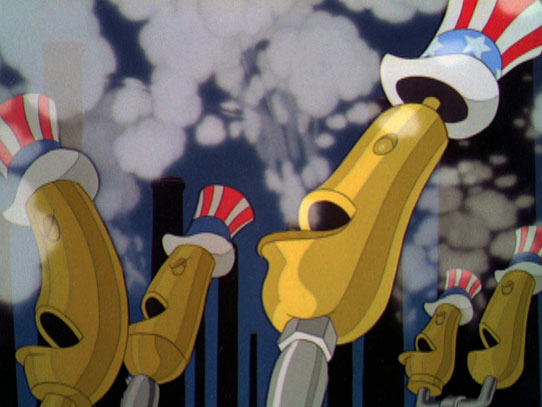
Scene 71, from The New Spirit, shows a row of Uncle Sam factory whistles blowing; ©Disney
The last half of the previous years The New Spirit was reused in The Spirit of ’43 based on the Treasury Departments request. Roy advised against the reuse, saying in a telegram to Walt that, “Regarding Treasury requests for some new material and there plans to reuse last half of New Spirit I recommend that you advise against any secondary use of New Spirit principally on the basis that its effectiveness because of reuse of old material which will be recognized will be lessened with the public and for that reason is poor economy.” He also recommended that the film be short because, “…with so many Government pictures crowding the screen time message can better put over by being short.” It’s clear that the Treasury got its way reusing the material from the last half, but The Spirit of ’43 is shorter film than The New Spirit.
 The Spirit of ’43 is also considered to be a stronger film than The New Spirit because Donald Duck is better as a character when he has an antagonist to work against, which is what made so many of the Donald shorts terrific, especially when he was pitted against Chip and Dale. In The New Spirit, it is just Donald and a radio announcer whereas in The Spirit of ’43 he plays off the spendthrift and the thrifty versions of himself. Also, the humorous gags are much stronger in this second film, which helps reinforce the message of paying your income taxes.
The Spirit of ’43 is also considered to be a stronger film than The New Spirit because Donald Duck is better as a character when he has an antagonist to work against, which is what made so many of the Donald shorts terrific, especially when he was pitted against Chip and Dale. In The New Spirit, it is just Donald and a radio announcer whereas in The Spirit of ’43 he plays off the spendthrift and the thrifty versions of himself. Also, the humorous gags are much stronger in this second film, which helps reinforce the message of paying your income taxes.
Clarence Nash does the voice of Donald Duck and Cliff Edwards, most famously known as the voice of Jiminy Cricket, does the singing voice over in both films. Fred Shields does the radio announcer voice in The New Spirit. Shields also provided the narrator voice for many Disney shorts including Donald’s Decision, Saludos Amigos, How to Play Baseball, How to Play Golf, El Gaucho Goofy, Victory Vehicles, Food Will Win the War, and many others.
Although these films were made as PSAs for paying your taxes, the re-use second half of the films falls into U.S. government propaganda. It was designed to inspire as well as bolster morale for the righteousness of America’s war effort. It was a different era when the entire country rallied against a common enemy, which defined what is now referred to as the “greatest generation” and the artists at the Disney studios played their part in that effort.

The war planes and military vehicles cycle as the clouds and stars form an American flag in the sky at the end of both The New Spirit and The Spirit of ’43, as the narrator says, “This is our fight… the fight for freedom… freedom of speech, of worship… freedom from want and fear… taxes will keep democracy on the march!” The Sportsmen Quartet softly sings ‘My Country, ‘Tis of Thee’ in the background; visual concept by Joe Grant; ©Disney
During that period, the Disney Studios relied heavily on these government-funded projects to help keep the studio financially afloat. It allowed Walt to retain employees he might otherwise have had to let go during the wartime economy. At the same time, those that worked on these shorts could take pride in their contributions towards helping America during difficult times.


 David A. Bossert is an award-winning artist, filmmaker, and author. He received his B.A. from CalArts School of Film and Video with a major in Character Animation. As a 32-year veteran of The Walt Disney Company, he contributed his talents to The Black Cauldron (1985), Who Framed Roger Rabbit (1988), The Little Mermaid (1989), Beauty and the Beast (1991), Aladdin (1992), Tim Burton’s The Nightmare Before Christmas (1993), The Lion King (1995), Fantasia/2000 (1999), and the Academy Award-nominated shorts Runaway Brain (1995), Dali/Disney Destino (2003), and Lorenzo (2004), among many others. Bossert is now an independent producer, creative director, and writer.
David A. Bossert is an award-winning artist, filmmaker, and author. He received his B.A. from CalArts School of Film and Video with a major in Character Animation. As a 32-year veteran of The Walt Disney Company, he contributed his talents to The Black Cauldron (1985), Who Framed Roger Rabbit (1988), The Little Mermaid (1989), Beauty and the Beast (1991), Aladdin (1992), Tim Burton’s The Nightmare Before Christmas (1993), The Lion King (1995), Fantasia/2000 (1999), and the Academy Award-nominated shorts Runaway Brain (1995), Dali/Disney Destino (2003), and Lorenzo (2004), among many others. Bossert is now an independent producer, creative director, and writer.













































































The acting in the scenes of Donald by the radio in THE NEW SPIRIT begging to help do his patriotic bit (at 1:37-1:53) is very well-done. I’d love to know who animated those scenes.
There has been talk around the ‘inter-webs’ (Twitter) that everyone’s favorite Rod Scribner possibly animated the scene in The New Spirit of Donald pleading to his radio (“I’ll do anything! ANYTHING!”). Just speculation or a different animator with a closer style..
https://twitter.com/AGuyWhoDraws/status/844928369561034752
I took his word on it, too, but I heard from IBCF (who I know is a little more reliable) on Twitter that Bob Carlson did that scene.
Taxes to bury the Axis. I remember seeing Spirit of 43 alongside Susie the Little Blue Coupe and Hooked Bear on a public domain VHS.
Yeah “Spirit of ’43” (and strangely not “The New Spirit” too) often got released on any number of Public Domain collections during the 80’s and 90’s. I used to see a tape having Donald on it with “The Spirit of ’43” written on the cover of a Toys R Us or Children’s Palace, not knowing what that was about other than the odd rarity of something Disney-related that apparently had a lapsed copyright of sorts involved (or not, depending on how they went about it in those days).
A slight correction: Barks didn’t do the Donald Duck comic strip. He did the Donald Duck comic [I] books [/I] which were done after he left Disney.
Yes, you are correct. Barks worked on the comics not the comic strips. Noted. Thank you!
Carl did contribute a few gags to the strip. This was mentioned in Mike Barrier’s Carl Barks and the Art of the Comic Book. And the estate included clippings so they are now documented in inducks.
https://inducks.org/creator.php?c1=date&c=CB
It is good to know that Barks did in fact contribute a few gags to the comic strips. These are the moments when I wish the artists back in the day were credited for the work that they did. Credits and attributions for animation and artwork are so helpful decades later.
It might be amusing to pair “New Spirit” with “Draftee Deffy”. The latter, released in ’45, opens with a wildly patriotic Daffy listening to the radio — then going into terrified panic when the little man from the draft board appears. While Daffy took on Nazis in other toons, this one ends with him still fleeing the draft.
https://youtu.be/UcpiLIq-mKQ
I’m not sure if this was a record or a radio commercial, but Yankee Doodle Spirit was used after The New Spirit, with Walt Disney talking to Donald about war bonds.